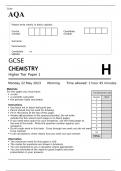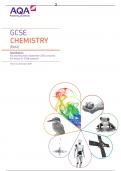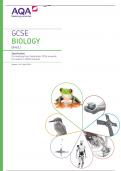Study guides, Class notes & Summaries
Looking for the best study guides, study notes and summaries about ? On this page you'll find 141 study documents about .
All 141 results
Sort by
This package contains the official question paper and final mark scheme
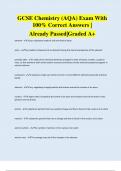
-
GCSE Chemistry (AQA) Exam With 100% Correct Answers | Already Passed|Graded A+
- Exam (elaborations) • 26 pages • 2024
-
- $16.83
- + learn more
element - A pure substance made of only one kind of atom atom - the smallest component of an element having the chemical properties of the element periodic table - a table of the chemical elements arranged in order of atomic number, usually in rows, so that elements with similar atomic structure (and hence similar chemical properties) appear in vertical columns. compound - A substance made up of atoms of two or more different elements joined by chemical bonds electron - A tiny, negatively...
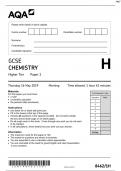
-
GCSE CHEMISTRY Higher Tier Paper 1 JUNE 2019Tested Questions
- Exam (elaborations) • 32 pages • 2024
-
- $4.99
- + learn more
0 1 This question is about the periodic table. In the 19th century, some scientists tried to classify the elements by arranging them in order of their atomic weights. Figure 1 shows the periodic table Mendeleev produced in 1869. His periodic table was more widely accepted than previous versions . 1 The atomic weight of tellurium (Te) is 128 and that of iodine (I) is 127 Why did Mendeleev reverse the order of these two elements?
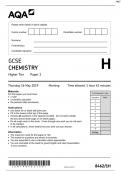
-
GCSE CHEMISTRY 8462/1 H -Higher Tier Paper JUNE 2019 Exam Questions
- Exam (elaborations) • 32 pages • 2024
-
- $4.69
- + learn more
0 1 This question is about the periodic table. In the 19th century, some scientists tried to classify the elements by arranging them in order of their atomic weights. Figure 1 shows the periodic table Mendeleev produced in 1869. His periodic table was more widely accepted than previous versions . 1 The atomic weight of tellurium (Te) is 128 and that of iodine (I) is 127 Why did Mendeleev reverse the order of these two elements? . 2 Mendeleev left spaces marked with an asterisk * He left...
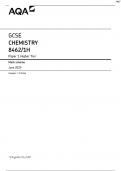
-
GCSE CHEMISTRY 8462/1H Paper 1 Higher Tier MS June 2019 100%CORRECT
- Exam (elaborations) • 26 pages • 2024
-
- $6.19
- + learn more
Question Answers Extra information Mark AO / Spec. Ref 01.1 any one from: • so elements / iodine / tellurium were in groups with similar properties • iodine has similar properties to Br / Cl / F / Group 7 • iodine has different properties to Se / S / O / Group 6 ignore reference to atomic structure ignore references to Cr, Mn and Mo allow corresponding argument in terms of tellurium 1 AO1 4.1.2.2 01.2 Mendeleev had predicted properties of missing elements ...
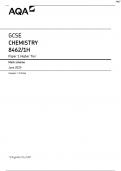
-
GCSE CHEMISTRY 8462/1H Paper 1 Higher Tier Mark scheme June 2019 Complete with Answers Verified and Graded
- Exam (elaborations) • 26 pages • 2024
-
- $5.78
- + learn more
Question Answers Extra information Mark AO / Spec. Ref 01.1 any one from: • so elements / iodine / tellurium were in groups with similar properties • iodine has similar properties to Br / Cl / F / Group 7 • iodine has different properties to Se / S / O / Group 6 ignore reference to atomic structure ignore references to Cr, Mn and Mo allow corresponding argument in terms of tellurium 1 AO1 4.1.2.2 01.2 Mendeleev had predicted properties of missing elements element...
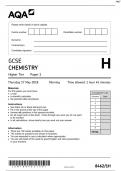
-
GCSE CHEMISTRY Higher Tier Paper 1 EXAM QUESTIONS
- Exam (elaborations) • 28 pages • 2024
-
- $4.99
- + learn more
1 Soluble salts are formed by reacting metal oxides with acids. box 0 1 . 1 Give one other type of substance that can react with an acid to form a soluble salt. [1 mark] 0 1 . 2 Calcium nitrate contains the ions Ca2+ and NO3 – Give the formula of calcium nitrate. [1 mark] 0 1 . 3 Describe a method to make pure, dry crystals of magnesium sulfate from a metal oxide and a dilute acid. 0 2 This question is about metals and metal compounds. box 0 2 . 1 Iron pyrites is an ionic compound....
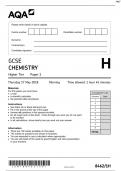
-
GCSE CHEMISTRY Higher Tier Paper 1 June 2018 Question Paper
- Exam (elaborations) • 28 pages • 2024
-
- $4.49
- + learn more
GCSE CHEMISTRYHigher Tier Paper 1 1 Soluble salts are formed by reacting metal oxides with acids. box 0 1 . 1 Give one other type of substance that can react with an acid to form a soluble salt. [1 mark] 0 1 . 2 Calcium nitrate contains the ions Ca2+ and NO3–Give the formula of calcium nitrate.[1 mark] 0 1 . 3 Describe a method to make pure, dry crystals of magnesium sulfate from a metal oxide and a dilute acid. 0 2 This question is about metals and metal compounds. box 0 2 . 1 Iron pyr...
GCSE CHEMISTRY (8462) with complete solution
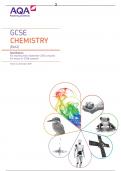
-
AQA-8462-SP-2016/ GCSE CHEMISTRY (8462)
- Exam (elaborations) • 112 pages • 2024
- Available in package deal
-
- $7.99
- + learn more
GCSE CHEMISTRY (8462)AQA-8462-SP-2016

